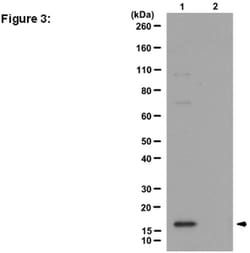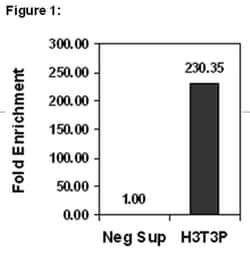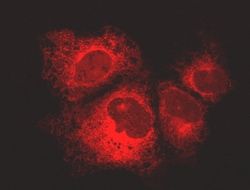MilliporeSigma™ Upstate™ Dimethyl-Histone H3 (Lys36), Rabbbit Polyclonal, ChIP Validated Antibody and Primer Set
Manufacturer: MilliporeSigma™
Select a Size
| Pack Size | SKU | Availability | Price |
|---|---|---|---|
| Each of 1 | 17-101-36MI-Each-of-1 | In Stock | ₹ 55,714.89 |
17-101-36MI - Each of 1
In Stock
Quantity
1
Base Price: ₹ 55,714.89
GST (18%): ₹ 10,028.68
Total Price: ₹ 65,743.57
Antigen
Dimethyl-Histone H3 (Lys36)
Classification
Polyclonal
Formulation
Anti-Dimethyl Histone H3 (Lys36) (Rabbit Polyclonal). One vial containing 25μL rabbit polyclonal serum containing 0.05% sodium azide, before the addition of 30% glycerol. Normal Rabbit Serum. One vial containing 25μL antiserum containing 0.05% sodium azide. ChIP Primers, GAPDH coding D2. One vial containing 75μL of 5μM of each primer specific for human GAPDH coding region. (chr12:6647453+6647539, hg 19 build). FOR: 5’ GCC ATG TAG ACC CCT TGA AGA GC 3’; REV: 5’ ACT GGT TGA GCA CAG GGT ACT TTA T 3’
Gene Symbols
H3.4, H3/g , H3/t, H3FT, H3T, H3t, MGC126886, MGC126888, OTTHUMP00000037945
Immunogen
KLH-conjugated linear peptide corresponding to a region near the N-terminus of human Histone H3 dimethylated at Lys36.
Regulatory Status
RUO
Primary or Secondary
Primary
Test Specificity
Recognizes Dimethyl Histone H3 (Lys36). No detectable cross-reactivity unmethylated, mono, or dimethylated Lys36. No detectable cross reactivity to other histone modifications as measured by AbSurance Histone Antibody Specificity Arrays.
Target Species
Human, Vertebrates
Form
Serum
Applications
ChIP Assay, Electromobility Shift Assay, Immunoprecipitation, Western Blot
Conjugate
Unconjugated
Gene Accession No.
Q16695
Host Species
Rabbit
Quantity
25 Assays
Research Discipline
Epigenetics and Nuclear Function
Gene ID (Entrez)
NP_003484
Includes
This ChIPAb+ Validated Antibody and Primer Set conveniently includes the antibody, matched IgG negative control antibody and set control PCR primers that detect a known positive locus.
Content And Storage
-20°C for up to 12 months from date of receipt; Upon first thaw and prior to removing the cap centrifuge the vial and gently mix the solution; Aliquot into microcentrifuge tubes and store at −20°C; Avoid repeated freeze/thaw cycles
Description
- Specifically detects Dimethyl-Histone H3 (Lys36) Clone: in Human, Vertebrate samples, and it is validated for ChIP, Electromobility Shift Assay, Immunoprecipitation, Western Blotting Histones are highly conserved proteins that serve as the structural scaffold for the organization of nuclear DNA into chromatin
- The four core histones, H2A, H2B, H3, and H4, assemble into an octamer (2 molecules of each)
- Subsequently, 146 base pairs of DNA are wrapped around the octamer, forming a nucleosome, the basic subunit of chromatin
- Histones are modified post-translationally by the actions of enzymes in both the nucleus and cytoplasm
- These modifications regulate DNA transcription, repair, recombination, and replication
- The most commonly studied modifications are acetylation, phosphorylation, methylation, and ubiquitination
- These modifications can alter local chromatin architecture, or recruit trans-acting factors that recognize specific histone modifications (the histone code hypothesis)
- The modifications occur predominantly on the N-terminal and C-terminal tails that extend beyond the nucleosome core particle
- Methylation of histone H3 on Lys36 (H3K36me2/3) is tightly associated with actively transcribed genes, and this modification is found primarily within the coding region, suggesting H3K36 methylation is necessary for efficient RNA polymerase II elongation and processivity.








